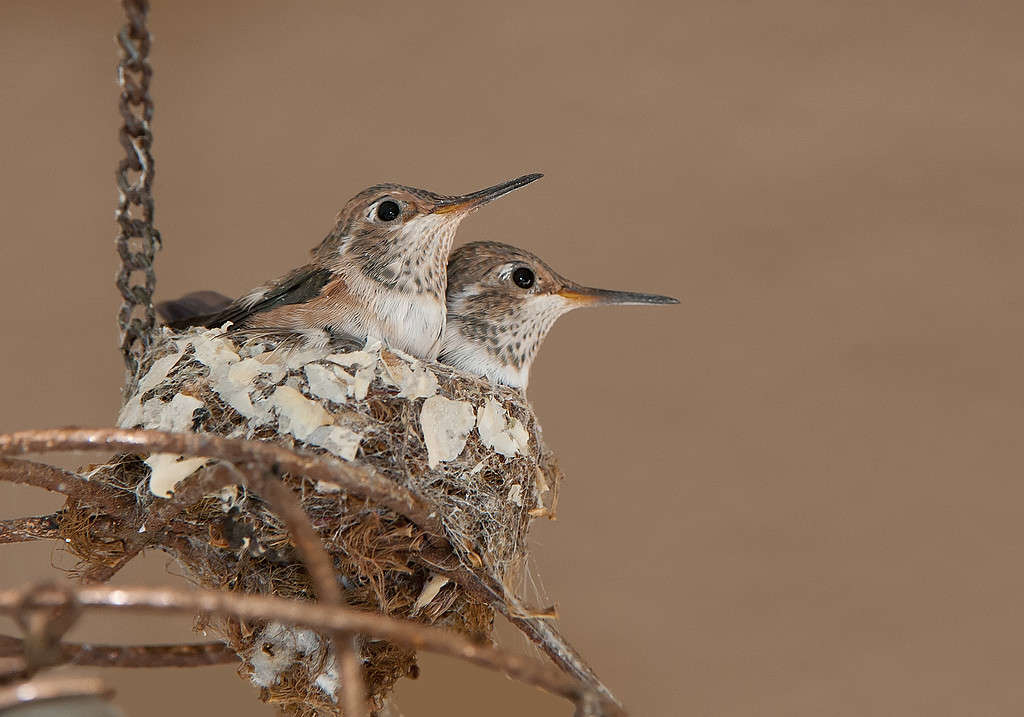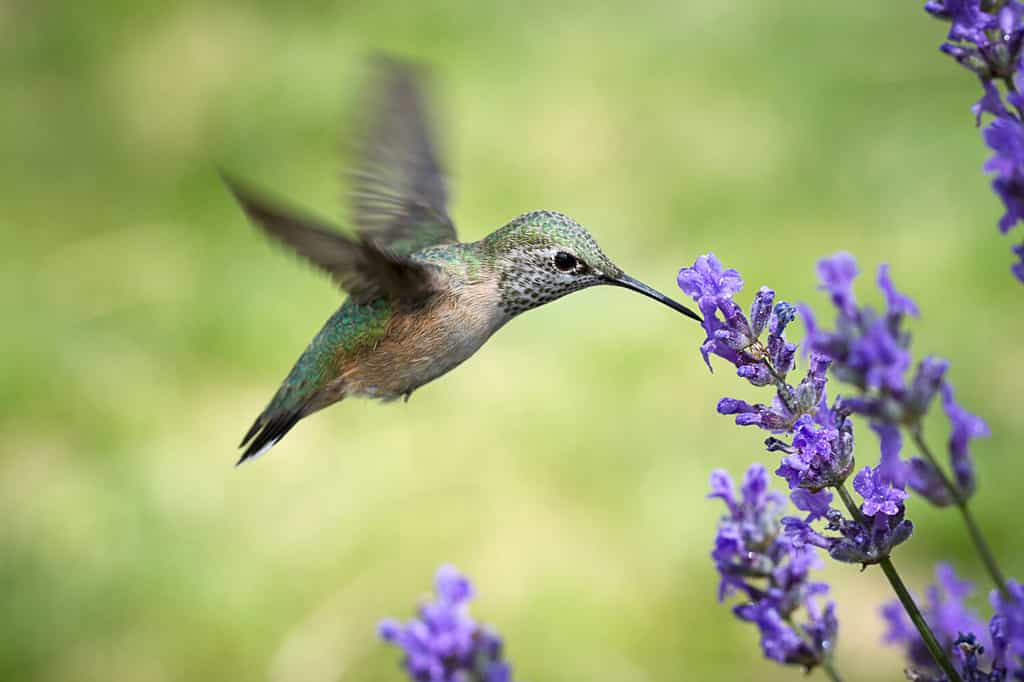You’ve seen hummingbirds flit rapidly from flower to flower, their wings a vibrant blur, but have you ever seen one resting? Most people haven’t, which has given rise to the widespread belief that hummingbirds must keep flying or die. But is this true or is it just a myth? If it’s a myth, what happens to hummingbirds when they stop flying? Read on to find out this and much more!
What Happens to Hummingbirds If They Stop Flying?

Contrary to popular belief, hummingbirds do not die if they stop flying.
©Christine Balleau/iStock via Getty Images
Hummingbirds do not die if they stop flying. The myth that they must keep flying or perish partially stems from the mistaken idea that they have no feet. Hummingbirds appear to be footless because they keep their feet tucked up against their bodies while in flight. In reality, they are fully capable of landing and standing.
Although they can land and perch, hummingbirds are unable to walk or hop due to the unique anatomical structure of their legs and feet. For one thing, hummingbirds have no knees. For another thing, their legs and feet are disproportionately short compared to their bodies. They can shuffle sideways but not take a step.
What Do Hummingbirds Do When Not Flying?

Hummingbirds sleep an average of 12 hours a night from dusk to dawn.
©roclwyr/iStock via Getty Images
When not flying, hummingbirds mainly sleep. These tiny birds need a lot of rest, typically 12 hours from dust to dawn. However, if they are especially tired or injured, they can sleep up to 18 hours in a row. When a hummingbird settles down to rest, it enters a state of torpor (a form of hibernation). This decreases their metabolism, including slowing their heart rate and dropping their body temperature. They may appear dead while in this state, but they are just resting.
Hummingbirds either sleep in nests or perch on branches with ample leaf cover to avoid predators. Often, they hang upside-down. It takes them a while to fully wake up from their torpor, usually about an hour. For this reason, they refrain from napping during the day.
Other Common Hummingbird Myths

Though hummingbirds love red tubular flowers, they also feed from a variety of other plants.
©R.C. Bennett/Shutterstock.com
In addition to the myths that hummingbirds die if they stop flying and have no feet, here are a few other common but false hummingbird myths:
- A hummingbird hanging upside down is dead. Hummingbirds frequently hang upside down to sleep. Their talons clamp down on the branch above to prevent them from falling.
- Hummingbirds perch on the backs of other birds during migration. Contrary to popular belief, hummingbirds do not catch rides on the backs of other birds to migrate. They tend to be extremely territorial, which means they aren’t likely to tolerate other birds in their immediate proximity. Instead, they complete their often lengthy and arduous journeys under their power.
- Hummingbirds only feed from red tubular flowers. Although hummingbirds prefer this type of flower, they feed from a variety of plants.
- Hummingbirds only eat nectar. Although hummingbirds certainly do enjoy nectar, they also eat insects, spiders, and tree sap.
- Hummingbirds use their tongues like straws to suck nectar. Hummingbird tongues are not hollow. In reality, they are forked with tiny hair-like fibers called lamellae. Once the hummingbird has extended its tongue into the flower, the tongue separates. As the hummingbird retracts its tongue, the lamellae and the closing forks trap the nectar.
- Adding red dye to water is a good way to attract hummingbirds. Although hummingbirds have an affinity for the color red, ingested dye can cause health problems. Sugar water is a safe and effective way to attract hummingbirds to a feeder.
- Keeping bird feeders out during the winter will prevent hummingbirds from migrating. Hummingbirds migrate in response to decreasing daylight hours, not food sources. You will not disrupt the migration patterns of local hummingbirds by leaving out bird feeders in fall and winter.
Bizzare But True Facts About Hummingbirds

Hummingbirds can fly backward and even upside down, beating their wings up to 80 times per second.
©Gregory Johnston/Shutterstock.com
Here are a few facts about hummingbirds that sound fake but are true:
- Hummingbirds don’t just fly forward – they also fly backward and upside down. Hummingbirds have the remarkable ability to twist their wings 180°, allowing them to fly in unorthodox patterns. This includes upside down, although they can only maintain this for a few seconds at a time.
- Hummingbirds are the only birds that can hover in midair. Hummingbirds possess the unique ability to hover in midair by rotating their wrist joints, which produces lift on both the downward and upward strokes.
- Hummingbirds fly at speeds of up to 60 miles per hour. Though a more typical hummingbird speed is 20-30 miles per hour, they can reach much greater top speeds during courtship dives.
- Hummingbirds can stop on a dime. These may be speedy little birds, but they can also stop at a moment’s notice. According to Audubon, hummingbirds can decelerate from 25 miles per hour to a full stop in the space of a human index finger.
- Hummingbirds beat their wings up to 80 times per second. Though it varies considerably from species to species (North American hummingbirds beat their wings about 53 times per second), some hummingbirds flap at a rate of up to 80 beats per second.
- Hummingbird hearts beat at up to 1,260 beats per minute. The heart of a hummingbird in flight beats extremely rapidly, usually somewhere between 500 and 1,260 beats per minute. However, when it enters a state of torpor, its heart can slow down to fewer than 50 beats per minute.
- Hummingbirds are extremely territorial. Despite their gorgeous appearance and cute physiques, hummingbirds can be mean-tempered. This is especially true when they are defending their territory or trying to claim a mate. These tiny birds have even been known to drive away much larger birds.
Conclusion
Contrary to popular belief, hummingbirds do not die when they stop flying. A hummingbird at rest is likely either sleeping or injured. If you see a hummingbird perched motionless on a branch, don’t disturb it – it’s likely not dead but rather in a state of torpor.
The photo featured at the top of this post is © Ondrej Prosicky/Shutterstock.com
Thank you for reading! Have some feedback for us? Contact the AZ Animals editorial team.







